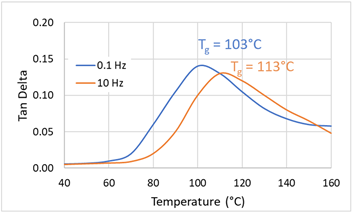

A polymer can act rubbery or glassy depending on its temperature or rate of deformation, such as from an impact. This is important for medtech devices that are stored at low temperature, vibrate, or are required to pass drop testing. In general, the quicker the polymer is impacted, the more brittle it acts and the greater the chance it will crack. Let’s examine why this phenomenon occurs, ways to measure it, and how to use material selection to avoid failures.
Some real-world examples are:
- An autoinjector drug-delivery device cracks after a larger drive spring is implemented. The larger drive spring releases faster which decreases impact time, thus causing the polymer to act more brittle.
- An ultrasound probe used to visualize a fetus in utero operates at 5 MHz and cracks a durable polymer housing with its high frequency signal.
The rubbery to glassy transition occurs at the polymer’s glass transition temperature (Tg). At temperatures lower than the Tg, the polymer acts glassy, whereas above it, the polymer acts rubbery. The transition is based on the amount of thermal movement that the polymer chains possess. Like a cold-blooded animal, at low temperatures the chains have slower, more limited mobility than at higher temperatures. Along the same lines, when impacted at low temperature the chains do not have time to rearrange and accept the stress, so the polymer responds plastically by cracking (glassy). At higher temperatures, the stress can be absorbed by fast chain movement and the polymer will respond elastically by absorbing the energy (rubbery).
This phenomenon also applies to the polymer’s behavior when impacted at different frequencies, such as spring size in an autoinjector. Frequency and impact time are inversely proportional (frequency = 1 / impact time), so a larger spring contacts the polymer with lower impact time, inducing higher frequency. Consider a polymer like polypropylene (PP) or silicone that is rubbery at room temperature. If the spring impacts the polymer faster than the chains can rearrange, then it will act glassy even though the temperature is above the Tg. The high frequency shifts the Tg to a higher temperature than its stationary Tg, making the polymer more susceptible to cracking.
The frequency induced shift in Tg can be experimentally determined using a dynamic mechanical analyzer (DMA). For frequencies less than 100 Hz this test is simple to run as temperature sweeps at multiple frequencies. The DMA oscillates a polymer, with small amplitude, and measures the in-phase component (storage modulus) and out-of-phase component (loss modulus). Tan Delta, the damping behavior, is the ratio of the loss to the storage moduli. A maximum in Tan Delta is a good indicator of the polymer’s Tg. As displayed in the figure, the Tg of polyethylene terephthalate (PET) shifts 10°C when the frequency is increased from 0.1 to 10 Hz.

Figure 1. Polyethylene terephthalate (PET) frequency induced Tg shift (plot reproduced from TA Instruments Thermal Analysis-2010 data)
Higher frequencies are common in medical applications and can cause large Tg shifts to occur. Consider the ultrasound probe that operates at 5 MHz; it can increase the Tg of a polymer by tens of degrees. This is enough to shift the Tg of PP from -10°C to ambient temperature. This shift can be estimated using the DMA by running frequency sweeps at multiple temperatures. Then, using time-temperature superposition (TTS) techniques, the data can be shifted out to higher frequencies to create a master curve in order to find Tg values at high frequencies. (For more background on TTS, see my earlier post on Long-term Polymer Properties). In essence, the lowest temperature data gets shifted to the highest frequency. This technique has been used to shift data orders of magnitude into the megahertz range and can explain how a silicone damping material can shatter when in use with a 5 MHz oscillating sensor.
When performing material selection to reduce the risk of product failure, there are many factors that must be considered. A polymer like PP might be chosen because it is inexpensive, easy to mold, and the data sheet indicates it has a high enough impact strength to pass a drop test at room temperature. However, when it is put into use in a high frequency device, it ultimately fails by brittle fracture. The Tg, how it will shift at use frequencies, and the product’s use temperature range should be considered in this scenario. The Tg is not always listed on the polymer’s technical data sheet, but a range for a class of polymers can be found in various technical resources. A rule of thumb is to choose a polymer that has a Tg at least 10°C away from the expected temperature range the product will encounter. For products that vibrate at high frequency or experience impacts like released springs or drops, a larger difference from the Tg should be implemented to avoid product cracking.
Unexpected failures can occur during prototyping if the dynamic polymer properties are not considered early in the design cycle. Once the injection molding tools have been machined, a material change can be costly and time consuming. Material choice and proper characterization of expected behavior across the product’s frequency and temperature use ranges will mitigate risk of failure.
If you would like to learn more about how to avoid these issues, contact Jeff Ellis at [email protected] or 614.688.5114.
To read more articles about avoiding material failure in plastic products by Jeff click here.